Madhava Nidana Chapter 2 Jwara Nidanam
Table of Contents
Introduction
In this article we are learning about Madava nidaana 2nd chapter “Jwara Nidaanam”. This chapter describes about the causative factors, pathology, types, symptoms and prognosis of fever.
Read – Acharya Madhavakara: His Work ‘Madhava Nidana’, Legacy, Amazing Facts

History of Fever
Origin / History of Jwara (fevers)
Long ago, Jwara was born from the wrath of Lord Rudra who had been insulted by Daksha. It is of eight types.
3 – One from each dosa (vātaja, pittaja and kaphaja),
3 – one each from the combination of two dosas (vāta pittaja,vāta kaphaja, pitta kaphaja),
1 – one from the combination of all the three doshas (sannipātaja, tridosaja) and
1 – one from āgantu (external causes). (1)
Read – Charaka Jwara Nidana: 1st Chapter
The eight kinds of fever are as listed below –
| Sl No | Category of Jwara | Names of Jwara |
| 1 | Eka doshaja – caused by single dosa | 1. Vataja 2. Pittaja 3. Kaphaja |
| 2 | Dwi dosaja / Dwandwa / Samsargaja – caused by two dosas | 4. Vata-pittaja 5. Vata-kaphaja 6. Pitta-kaphaja |
| 3 | Tridosaja / Sannipataja – caused by three dosas | 7. Vata-pitta-kaphaja |
| 4 | Agantuja – caused by external causes | 8. Agantuja |
Read – Types Of Jwara According To Ayurveda: Jwara Bheda
Jwara Samprapti
Jwara Samprapti – pathogenesis of fever
Due to improper foods and activities, the Doshas (vāta, pitta and kapha) undergo an increase (individually or in combination). These vitiated doshas reach the āmāśaya (stomach and intestines) and expel the kosthāgni (digestion fire) to the exterior (skin and other tissues) and circulating along with rasa (dhātu) produces jwara. (2)
The events leading to manifestation of jwara (fever) – pathogenesis of jwara
- Indulgence in improper foods and activities
- Doshas undergo abnormal increase / aggravation either individually or in combination
- The increased doshas reach the stomach / intestines
- Causes expulsion of the gastric fire to the exterior
- The same doshas circulate along with the blood plasma
- Produce jwara – fever
Read – Jwara Pravritti, Prakriti: Initiation and Nature of Fever
Definition of Jwara
Jwara is defined as the disease in which there is obstruction to perspiration, increase of body temperature and pain all over the body. All these symptoms occur and exist together. (3)
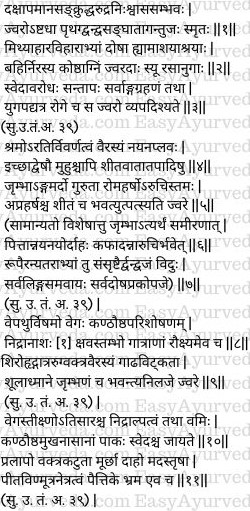
Jwara Purvarupa
Purvarupa – Premonitory symptoms of Jwara
Shrama – Fatigue,
Arati – restlessness,
Vivarnatva – discoloration of the skin,
Vairasya – bad taste in the mouth,
Nayana Plava – eyes full of tears,
Iccha Dvesho Muhushcapi Sheeta Vata Atapadishu – alternate like and dislike for cold wind and warm sunlight, etc.,
Jrumbha – yawning,
Angamarda – body ache,
Guruta – feeling of heaviness of the body,
Romaharsha – horripilation (body hairs standing on ends),
Aruchi – lack of appetite,
Tama – stupor,
Apraharsha – lack of interest in anything and
Sheeta – feeling of cold are the symptoms generally appearing earlier to the actual onset of fever (premonitory symptoms).
Even among these (premonitory symptoms),
- Yawning will be more, if vātaja jwara were to manifest later,
- Burning sensation will be found if pittaja jwara were to manifest later and
- Lack of appetite will be found if kaphaja jwara were to manifest in future.
Similarly, the symptoms of two or three došhas will appear in fevers caused due to a combination of two or three doshas respectively. (4-7)
Read – Ayurveda Lifestyle and Diet For Fever – 45 Important Things
Symptoms of Vataja Jwara
The symptoms of Vātaja jwara (fever due to the increase of vāta doşa) are – shivering (chill, rigours), non-corresponding time of onset and exacerbation, severe dryness of the throat and lips, loss of sleep, absence of sneezing, roughness of the skin (or decrease of moisture in the body) pain in head, chest and body, bad taste in the mouth, hard and dry faeces, pain in the abdomen, distension of abdomen and too many yawning. (8-9)
Symptoms of Pittaja Jwara
The symptoms of Pittaja Jwara (fever due to the increase of pitta doşa) are – very high temperature, diarrhoea, very little sleep, vomiting, ulcers in the throat, lips, mouth and nose, perspiration, delirium, bitter taste in the mouth, fainting, feeling of burning sensation all over the body, intoxication, thirst, yellow colouration of faeces, urine & eyes, etc., and giddiness. (10-11)
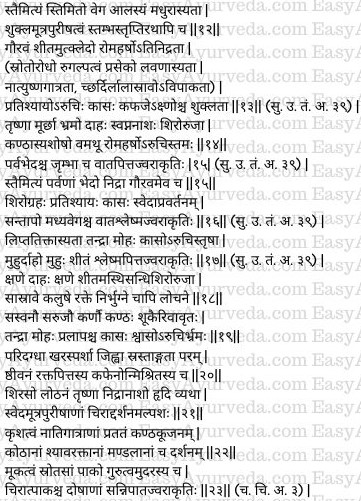
Symptoms of Kaphaja Jwara
The symptoms of Kaphaja Jwara (due to increase of kapha doşa) are – feeling of stiffness / cold all over the body, mild increase of temperature, lack of enthusiasm, sweet taste in the mouth, whitish urine and faeces, stiffness of extremities, abnormal feeling of contentment, feeling of heaviness, cold, nausea, horripilation, excessive sleep; obstruction to the channels, mild pains, excessive salivation, salty taste in the mouth, temperature is not very high, vomiting, saliva flowing out, indigestion of food, running nose, lack of appetite, cough and whitish eyes. (12-13)
Symptoms of Vatapitta Jwara
The symptoms of Vata-pittaja jwara are – thirst, fainting, giddiness, burning sensation, loss of sleep, headache, dryness of throat and mouth, vomiting, horripilation, loss of taste (tastelessness), feeling of darkness before the eyes, pain in the small joints of hands and feet and yawning. – (14-15)
Symptoms of Vatakapha Jwara
The symptoms of Vata-kaphaja jwara (fever caused by combination of increased vata and kapha doshas) are – feeling of stiffness / cold in the body, pain in the small joints of hands and feet, too much of sleep, feeling of heaviness of the body, headache common cold / running nose, cough, lack of perspiration (sweating) and moderate increase of body temperature. (15-16)
Symptoms of Kapha-pitta Jwara
The symptoms of Kapha-pittaja jwara are – coating of the tongue, manifestation of bitter taste in the mouth, drowsiness, delusion, cough, loss of taste, thirst, alternate feeling of heat and cold. (17)
Symptoms of Sannipata Jwara
The symptoms of Sannipatajwara (caused by combination of all the three doshas) are – feeling of heat and cold alternately, pain in the bones and joints, headache, eyes full of tears, dirty, reddish and bulging out; ringing and pain in the ears, feeling of thorns pricking inside the throat, drowsiness, delusion, delirium, cough, difficulty in breathing (dyspnoea), loss of taste, giddiness, tongue angry red at its edges and rough, weakness of the limbs, excessive expectoration of sputum mixed with blood and bile, rolling of the head on the pillow, thirst, loss of sleep, pain in the heart (or region of the heart), elimination of small quantities of sweat, urine and faeces at long intervals, not much of wasting of the body, continuous moaning (feeble sound in the throat), appearance of dark red spots and patches on the skin, dumbness (unable to speak), ulceration of the orifices of the body, feeling of heaviness of the abdomen, doshas undergoing paka (return to normalcy) very slowly. (13-23)
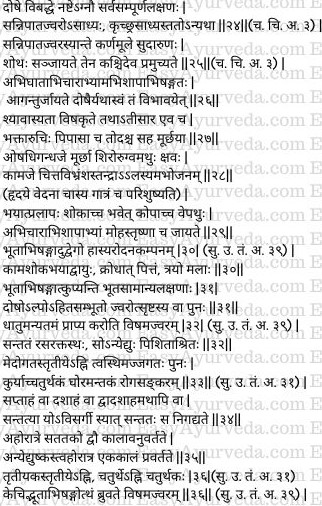
Prognosis of Sannipata Jwara
Sannipata jwara becomes incurable if the dosas are stagnated (profound and deep seated), if the digestive capacity of the patient is completely diminished and if all the symptoms are simultaneously manifested. Otherwise it is curable with difficulty. (24)
Sometimes there appears a profound swelling at the root of the ear at the end of the course of sannipata jwara and hardly anybody can get rid of it (it almost causes death). (25)
Read – Puerperal Fever, Causes, Symptoms, Treatment – Sutika Jwara
Agantuja Jwara
Agantu Jwara is caused by – abhighata (assault by weapons), abhichara (sorcery and witchcraft), abhishapa (curse by godly men) and abhyanga (possession by evil spirits, infection by microorganisms). Even in such fevers the symptoms of doshas have to be recognised. (26)
Symptoms of different types of Agantuja Jwara
In agantu jwara caused by poison – bluish discolouration of the mouth, diarrhoea, loss of appetite, thirst, pain and fainting are seen.
In fever caused by smell of plants (pollen of flowers, etc.) – fainting, headache, vomiting and sneezing are seen.
In fever caused due to love or passion – mental aberration, stupor, inactivity or laziness and lack of interest in food, pain in the heart and emaciation of the body are the symptoms.
In fever caused due to fear and grief – the patient will be having delirium.
In fever caused due to anger – he will have tremors.
In fever caused due to sorcery and curse – the patient will be having delusion and thirst.
In fever caused due to possession by evil spirits – the patient will be highly emotional (irritable) and indulges in excess of laughing, weeping and shivering. (27-29)
Vata gets increased by lust, grief and fear. Pitta gets increased by anger. All the three doshas get increased from possession by evil spirits (or bacterial infection) and show their specific features. (30)
Read – Charaka – Jwara Chikitsa 3rd Chapter
Vishama Jwara
Vishama Jwara – meaning and pathogenesis
Doșhas which have undergone slight / mild increase right from the beginning or the small quantities of doshas which have remained after the fever has gone away get aggravated once again due to consumption of unsuitable foods and activities, get lodged in one or the other dhātus (tissues) and produce Visama jwara (irregular or intermittent fevers). (31).
Types
Types of Visama Jwara and their relationship with tissues
Of such fevers, santata jwara involves rasa and rakta dhatus, anyedyuska jwara involves mamsa dhatu, tritiyaka jwara involves medas, caturthaka jwara involves asthi and majja dhatus, which is a dreadful disease-complex and is even fatal. (32-33)
Read – Vishama Jwara Definition, Causes, Types, Symptoms, Treatment
Symptoms of Santata and other types of Visama Jwaras
- Santata jwara is so named because the fever continues without remission for seven, ten, twelve or even more days.
- Satataka jwara manifests twice in twenty four hours.
- Anyedyuska jwara manifests once in twenty four hours.
- Tritiyaka jwara manifests on alternative days.
- Caturthaka jwara manifests on every fourth day. (34-35)
Some scholars opine that visama jwaras (intermittent fevers) are caused due to bhutabhisanga (bacterial infection). (36)
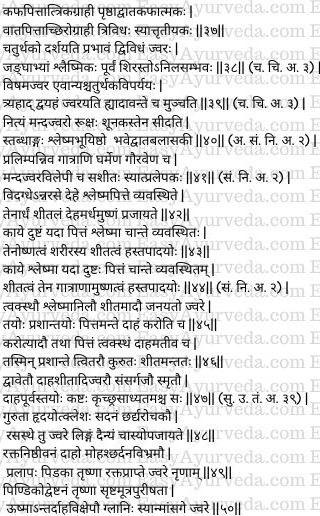
Tritiyaka Jwara
Types of manifestation of Tritiyaka Jwara
Tritiyaka jwara manifests in three ways viz,
- if kapha and pitta are increased, fever starts with catching pain in the lower portion of the back,
- if vāta and kapha are increased, the fever starts with pain in the upper portion of the back and
- if vāta and pitta are increased, the fever starts with pain in the head. (37)
Caturthaka Jwara
Types of manifestation of Caturthaka Jwara
Chaturthaka also manifests in two ways,
- if kapha is increased, fever starts with pain in the calf muscles and
- if vata is increased it starts with pain in the head. (38)
Chaturthaka Viparyaya Jwara
There is yet another kind of visama jwara known as chaturthaka viparyāya jwara. In this condition, fever is not found on the first and fourth day but found on two days in the middle. (39)
Read – Ayurveda Home Remedy For Fever
Vata balasaka Jwara
Vata balasaka jwara is produced by increase of kapha and manifests as mild fever daily with dryness, oedema, debility and feeling of stiffness of the body. (40)
Pralepaka Jwara
Pralepaka jwara manifests with mild fever as though the skin is given a thin coating of heat, accompanied with a feeling of heaviness and cold. (41)
Ardhanga Santapayukta Jwara
If the annarasa (nutrient portion of the food) gets vidagdha (overcooked due to increase of pitta during the process of digestion), there manifests a fever with half the body being hot and the other half being cold. When pitta gets increased in the trunk followed by kapha in the extremities, then the fever manifests with the trunk being hot and with hands and feet (extremities) cold. When kapha is increased in the trunk and pitta in the extremities, fever manifests with the trunk being cold and the hands and feet (extremities) hot.
Note: These fevers are called Ardhanga Santapa Jwara wherein the rise of heat is evident in half of the body (with coldness prevailing in the other half of the body). They are special types of Visama Jwara.
Read – Understanding Digestion Process From An Ayurveda View
Shitapurva and Dahapurva Jwara
When the aggravated kapha and vāta lodged in the skin, there is a manifestation of cold (rigours) at the beginning of fever. Later when its bouts reduce, the patient experiences burning sensation (heat) due to pitta at the end of the fever.
Similarly, when the aggravated pitta is lodged in the skin, there is a manifestation of burning sensation (heat) at the beginning of the fever. Later when its bouts reduce, the patient experiences cold (rigours) due to vata and kapha at the end of the fever.
These two types of fevers dāhapūrva (preceded by heat) and śītapūrva (preceded by cold) are samsargaja i.e. produced by the combination of two dosas. Among these fevers dāhapūrva is difficult to treat and is almost incurable. (42-47)
Read – Causes, Symptoms, Treatment Of Recurring Fevers Punaravartaka Jwara
Dhatugata Jwara
Dhatugata Jwara – fevers localised in the tissues
Rasa dhatu gata jwara
Fever residing in rasa tissue
The symptoms seen when jwara (fever) invades / resides in rasa dhatu (blood plasma) is – feeling of heaviness of the body, nausea, debility, vomiting, loss of appetite and timidity (feeling of helplessness). (48)
Rakta dhatu gata jwara
Fever residing in blood tissue
The symptoms evident when fever invades / resides in rakta dhatu (blood) is – haemoptysis, burning sensation, delusion, vomiting, dizziness, delirium, appearances of rashes (or small boils) on the skin and thirst. (49)
Mamsa dhatu gata jwara
Fever residing in muscle tissue
The symptoms found when fever invades / resides in c(muscle tissue) is – pain in the calves, thirst, increased elimination of urine and faeces, high temperature, burning sensation inside, involuntary movements of the hands and feet and exhaustion manifest. (50)
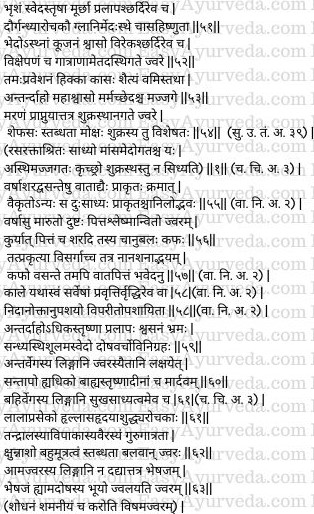
Medo dhatu gata jwara
Fever residing in fat tissue / adipose tissue
The symptoms found when fever invades / resides in medo dhatu (fat / adipose tissue) is – profuse sweating, thirst, fainting, delirium, vomiting, bad smell from the body, loss of taste (anorexia), exhaustion and intolerance (irritability). (51)
Asthi dhatu gata jwara
Fever residing in bone tissue
The symptoms found when fever invades / resides in asthi dhatu (bone tissue) is – splitting pain in the bones, low and indistinct sound from the throat (moaning), dyspnoea (increased respiration), diarrhoea, vomiting and throwing / involuntary movements of hands and feet. (52)
Majja dhatu gata jwara
Fever residing in bone marrow tissue
The symptoms found when fever invades / resides in majja dhatu (bone marrow tissue) is – appearance of darkness before the eyes (feeling as if immersed in a zone of darkness), hiccough, cough, cold feeling, vomiting, burning sensation within the body, severe dyspnoea (greatly increased respiration) and cutting type of pain in the heart and other vital spots of the body. (53)
Shukra dhatu gata jwara
Fever residing in semen / reproductive tissue
The symptoms found when fever invades / resides in shukra dhatu (semen tissue / reproductive tissue) is – constant erection of the penis and profuse discharge of semen followed by death. (54)
Read – Dhatugata Avastha of A Disease
Prognosis
Prognosis of fevers residing in the tissues
Fever invading / residing in rasa and rakta (blood plasma and blood) tissues can be cured easily.
Similarly, the fevers residing in mamsa and medo dhatus (muscle and adipose / fat) tissues are also easily curable.
The fevers residing in asthi and majja (bones and bone marrow) tissues are difficult to cure.
The fever residing in shukra (semen, reproductive tissue) tissue does not respond to the treatment i.e. it is incurable). (54-1)
Read – Use Of Herbal Decoctions In Fever -Kashaya In Jwara
Fever based on Season
Prakrta (normal) and Vaikrta (abnormal) fevers explained on the basis of the seasonal relationship with the fevers
Fevers which manifest in varsa rutu (rainy season), Sarad rutu (autumn) and vasanta rutu (spring season) caused by vata, pitta and kapha respectively are considered as prakrta (normal / corresponding to the season). Apart from these fevers, the other fevers shall be considered as vaikrta (abnormal / not corresponding to the season). Prakrta fevers are easily curable. But vatika fever (fever caused by predominance of vata), though is prakrta (occurring in its normal season i.e., varsa rutu) cannot be easily treated. The fevers produced by vata are difficult to treat. Likewise, the Vaikrta fevers are also difficult to treat. (55)
Doshas and seasonal fevers
- In Varsa Ritu (rainy season) – the vitiated vata produces fever being associated with pitta and kapha.
- In Sarad Ritu (autumn season) – pitta produces fever being associated with kapha.
- Fasting or therapeutic starvation doesn’t do harm in both these conditions because of the nature of associated doshas and nature of the season (visarga – cold predominant season).
Note – Reason behind administering fasting in rainy and autumn seasons – By nature pitta and kapha have fluid nature and can tolerate fasting. So, fasting can be readily recommended in Prakrata Vata fever occurring in the rainy season, especially when it is associated with pitta and kapha. The same rule is applicable in pitta fever associated with kapha occurring in Sharad Ritu also. Also – both these seasons (rainy and autumn) fall in visarga kala (cold predominant seasons) and hence fasting is recommended (the strength of the patients in these seasons is comparably good in comparison to heat predominant seasons).
In Vasanta Ritu (spring season) – the fever produced by vitiated kapha will probably have association and support of vata and pitta. (56-57)
Read – Relationship Of Doshas With Seasons
Upashaya and Anupashaya
Upashaya (subsiding factors) and Anupashaya (aggravating factors) for fevers in relation to the causative dosas
It is only at that specified time / season during which the causative dosa is aggravated (powerful), we usually get to see the onset or exacerbation of the fevers.
Also, the factors (etiological factors) responsible for increasing a particular dosha also bring about an increase (onset or exacerbation) of the fever (caused by that particular dosha). On the other hand, the opposites (anything which is opposite to those mentioned amongst the etiological factors for that particular dosha) will be helpful and would mitigate the fever also.
Note: This means to tell that all fevers (usually) have their onset or exacerbation in accordance to their respective dosha aggravating time or season.
Upasaya and Anupasaya mentioned here can also be used as tools for identifying the dosha involved in the causation of a given fever. (58)
Read – Upashaya Anupashaya – Pacifying And Non-Pacifying Factors Of Disease
Antarvega and Bahirvega Jwaras
Antarvega Jwara (fevers predominantly manifesting from within or residing inside the body) – is diagnosed by the presence of symptoms including – feeling of burning sensation inside (the body), excessive thirst, delirium, dyspnoea, giddiness, pain in the joints and bones, absence of perspiration and non-elimination of doshas and faeces.
Bahirvega Jwara (fevers predominantly manifesting from without or residing / manifesting outside, on the surface of the body) – is diagnosed by the presence of very high temperature externally, but thirst and the other symptoms (mentioned in antarvega jwara) being mild. This condition is said to be easily curable. (59-60)
Ama Jwara Symptoms
The symptoms of ama jwara (unripe, early / first or initial stage of fever) are – profuse salivation, nausea, heaviness and oppression in the region of the heart (a strange discomfort in the cardiac region), loss of taste / appetite, drowsiness, laziness / lack of enthusiasm, indigestion, bad taste in the mouth (manifestation of abnormal tastes / opposite tastes in the mouth), feeling of heaviness of the body, loss of hunger, profuse urination, stiffness and high temperature.
During this stage of fever, treatment should not be given. If given, the medicines will cause an increase (in the severity) of fever. Also if sodhana (Panchakarma) and samana (palliative) therapies are administered in ama jwara, they will lead to Visama Jwara (irregular fevers). (61-63)
Read – Association Of Ama With Doshas, Tissues And Waste Products
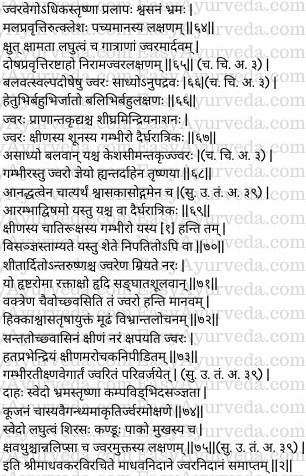
Pacyamana Jwara Symptoms
The symptoms of Pachyamana Jwara (intermediate / middle stage or stage of ripening of the fever) are – severity in fever or bouts of fever, severe thirst, delirium, dyspnoea, giddiness, frequent elimination of faeces and nausea. (64)
Nirama Jwara Symptoms
The symptoms of Nirama Jwara (last stage of the fever / fever having absence of ama) are – appearance of hunger, slight emaciation and feeling of lightness of the body, decrease in intensity / temperature of the fever, elimination of dosas (and also feces, urine etc.) and fever entering into the eighth day are the symptoms of Nirama jwara (fully ripe or terminal stage of fever). (65)
Read – Ama Chikitsa: Treatment For Ama And Saama Conditions
Signs of curability
Fever affecting strong persons, produced by less dosas (dosas which are not severely aggravated) and having no complications are easily curable.
Signs of incurability
Fevers caused by many and powerful causes, manifesting with many and powerful symptoms, those which destroy the sense faculties (sense organs) in quick time will be life threatening and incurable. Similarly, strong (severe) fevers affecting persons who are very weak and afflicting those having oedema all over the body, which are deep seated (in the tissues), continuing for long periods (has become chronic) and those causing furrows in between the hairs of the head all of a sudden -are also difficult to treat or incurable. (66-67)
Gambhira Jwara
- The fever which manifests with burning sensation inside the body, thirst, severe distension of the abdomen, dyspnoea and cough is called as Gambhira Jwara. (68)
- Fever which is irregular even from its commencement, is chronic (continuing for long periods) is incurable. Likewise, gambhira (and antardaha jwara) fever affecting persons who are weak or having dryness of the body is also incurable.
- The patient will face death if the fever presents with loss of consciousness, darkness before the eyes, fainting – here the patient keeps laying down as he is not capable of getting up from that position, feeling cold externally and very hot internally (inside the body).
- The fever is considered incurable and also tends to kill the person when it presents with frequent horripilation, redness of the eyes and pain as if injured by stone and similar other things in the region of the heart, patients breathing only through their mouth.
- Fever associated with hiccough, increased respiration, thirst, delusion, unsteady gaze, interrupted respirations (more expiration and fewer inspirations), severe emaciation will destroy the person (is incurable).
- The patients of fever having loss of complexion and sensory activities, extreme debility, loss of appetite, deep seated fever, and having very high temperatures are to be refused treatment (because such a fever is incurable). (39-73)
Purvarupa of subsiding fever
Premonitory symptoms of subsiding fever
The symptoms of fever which is subsiding are – burning sensation, perspiration, giddiness, thirst, tremors, elimination of feces (diarrhea), loss of consciousness, making indistinct sounds (moaning) and bad smell from the mouth. (74)
Symptoms of relieved fever
The symptoms of the person who has been relieved from fever are – perspiration, feeling of lightness of the body, itching of the head, appearance of ulcers in the mouth, sneezing and desire for food. (75)
Thus ends the chapter on Jwara in Madhava Nidana, written by Acharya Madhavakara











